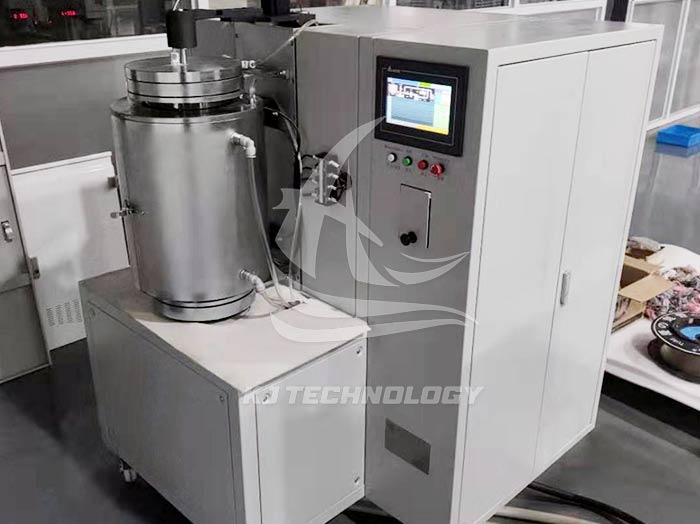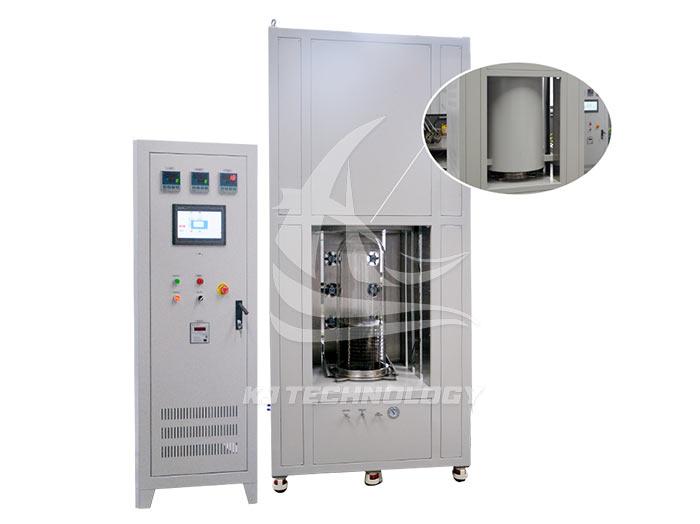Advantages of electric heating vacuum brazing furnace
 09-24-2025 Author: KJ technology
09-24-2025 Author: KJ technology
The electric heating vacuum brazing furnace combines vacuum environment, electric heating technology, and precision temperature control system, and has significant advantages in welding quality, material adaptability, and process stability. The following is a detailed analysis of its core advantages:
1. Excellent welding quality
No oxidation, no pollution:
The vacuum environment (pressure can be as low as 10 ⁻⁴ Pa) thoroughly eliminates active gases such as oxygen and water vapor, avoiding the oxidation or formation of brittle compounds (such as alumina and copper oxide) of the base material and brazing material at high temperatures. The surface of the welded joint is bright and dense, without defects such as pores or slag inclusions, and has higher strength.
Low volatile loss:
Vacuum environment reduces the volatilization of low melting point elements (such as zinc, magnesium, manganese) in materials, maintains the uniformity of chemical composition in welded joints, and is particularly suitable for welding high-precision alloys (such as nickel based high-temperature alloys and titanium alloys).
High density:
After melting under vacuum, the surface tension of the brazing material decreases, and the wettability is significantly improved. It can fully fill the gaps between the base materials, form defect free metallurgical bonds, and have excellent airtightness.
2. Wide adaptability of materials
Welding of dissimilar materials:
It can achieve reliable connection of dissimilar materials such as aluminum copper, steel aluminum, ceramic metal, etc., breaking through the limitations of traditional welding methods on differences in material melting points and thermal expansion coefficients. For example, vacuum brazing of aluminum heat sinks and copper pipes balances the lightweight of aluminum and the high thermal conductivity of copper.
Complex structure welding:
Suitable for welding thin-walled parts (thickness<0.1mm), slender parts (aspect ratio>50:1), and multi-channel structures (such as plate fin heat exchangers), with small deformation (<0.05mm) and no need for subsequent corrective processing.
Welding of special materials:
For difficult to weld materials such as high-temperature alloys (such as Inconel 718), heat-resistant steels (such as 310S stainless steel), and active metals (such as titanium and zirconium), vacuum brazing can avoid oxidation and cracking, resulting in a higher welding qualification rate.
3. High process stability
Accurate temperature control:
Using S-type or B-type thermocouples (temperature measurement range 0-1800 ℃) combined with PID algorithm, the temperature fluctuation is within ± 5 ℃ to ensure the uniformity of solder melting. For example, when brazing aircraft engine blades, the temperature gradient needs to be controlled within ± 5 ℃, which can be easily met by a vacuum brazing furnace.
Adjustable vacuum degree:
According to the process requirements, the vacuum degree can be adjusted within the range of coarse vacuum (10 ⁵ -10 ⁻¹ Pa) to high vacuum (10 ⁻⁴ Pa). High temperature brazing (>1000 ℃) requires high vacuum to prevent oxidation, while low-temperature brazing (<600 ℃) can use low vacuum to reduce costs.
Good repeatability:
Under the same process parameters, the welding quality consistency of different batches of workpieces is high, which is suitable for large-scale industrial production. For example, the yield rate of vacuum brazing for car radiators is higher.
4. Environmental protection and energy-saving advantages
No flux, no smoke:
Traditional flame brazing requires the use of flux (such as borax) to remove oxides, but residual flux can lead to corrosion and electrochemical failure. Vacuum brazing does not require flux, avoiding harmful gas emissions.
High thermal efficiency:
Electric heating systems (such as graphite heaters) have higher thermal efficiency, much higher than gas heating, and produce no combustion exhaust gas, reducing energy consumption and carbon emissions.
Waste heat recovery:
Some equipment is equipped with waste heat recovery devices, which use the heat from cooling water to preheat workpieces, further saving energy.
5. High level of automation and intelligence
Full process automation:
From loading, vacuuming, heating, insulation, cooling to unloading, all can be automated through a PLC control system, reducing manual intervention and improving production efficiency.
Remote monitoring and diagnosis:
It supports industrial Internet access, monitors vacuum, temperature, pressure and other parameters in real time, and predicts equipment failure through big data analysis to achieve preventive maintenance and reduce downtime.
Process database management:
Built in brazing process curves for hundreds of materials (such as heating rate, holding time, cooling rate), which users can directly call or customize to shorten the process development cycle (from weeks to days).
6. Significant comprehensive cost-effectiveness
High yield rate:
Lower welding defect rate, reducing repair and scrap costs. For example, the scrap cost of vacuum brazing for aircraft engine blades can reach hundreds of thousands of yuan per piece, and a high yield rate directly reduces production costs.
Extended lifespan:
Vacuum brazed joints have excellent corrosion resistance and fatigue resistance, and the service life of equipment is extended. For example, vacuum brazed heat exchangers in petrochemical equipment have an extended service life of several years.
Multi process integration:
It can be combined with heat treatment (such as annealing, aging), surface treatment (such as coating) and other processes to achieve "one furnace for multiple uses", reducing equipment investment and footprint.
Typical application cases validate advantages
Aircraft engine blades:
A certain type of aircraft engine uses vacuum brazing to connect stator blades, which improves welding strength and extends fatigue life, meeting military standards.
Car radiator:
A certain car company has replaced traditional nitrogen protection brazing with vacuum brazing, which has improved the qualification rate of radiator airtightness and saved annual costs.
Electronic packaging:
A semiconductor company uses vacuum brazing to prepare ceramic coated copper substrates, which improves thermal conductivity, reduces chip operating temperature, and significantly improves reliability.








